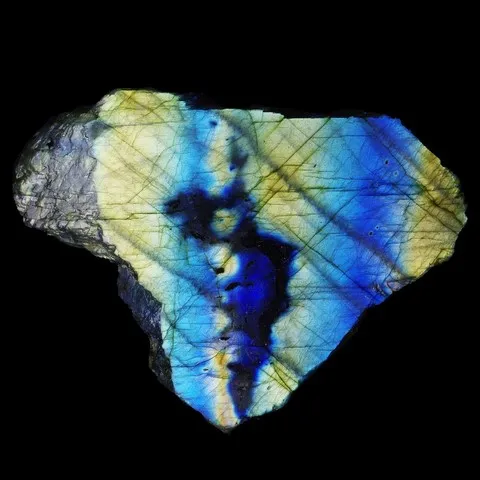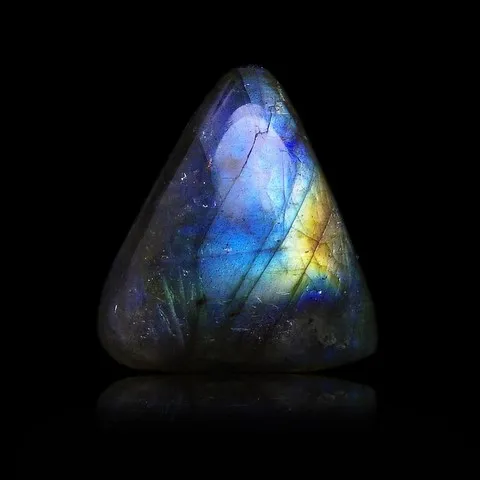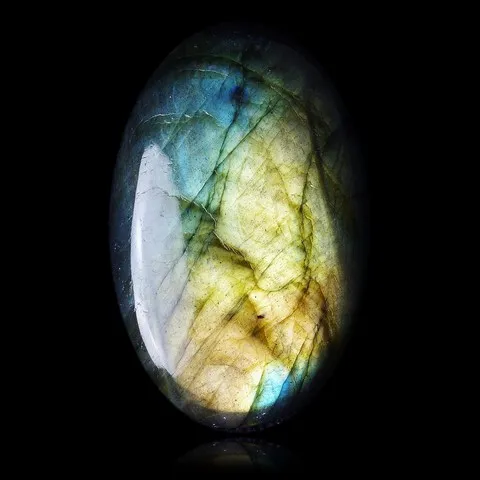LABRADORITE
Class : Silicates
Subclass : Tectosilicates
Crystal System : Triclinic
Chemistry : (Ca, Na)(Al, Si)4O8
Rarity : Common
Labradorite is a rock with pretty blue, yellow, green and sometimes purple reflections and composed of crystals of plagioclase feldspars of labradorite or bytownite but mostly of anorthite. Labradorite rock is named after the plagioclase feldspar labradorite found on Paul Island, Labrador Peninsula, Canada in norites (but absolutely not characteristic of the species) and is frequently confused or equated with it. Labradorite is derived from the pegmatitoids of basic rocks (basalts, diorites, andesites, norites, etc...) and anorthosites. It is a stone enormously used in the ornamentation (sculptures, funerary monuments) and it is much cut in cabochons and appreciated in jewelery because of its pretty shimmering colors.
Labradorescence :
Labradorescence is the international term for the particular reflection of light by planes oriented in one direction (sometimes in two directions) and of the same thickness as the wavelengths of visible light (a few hundred nanometers). In physics we speak of interference, it is this phenomenon which is responsible for the metallic color of the carapace of certain beetles for example. These planes are not directly visible under the microscope.
This optical phenomenon is therefore linked to the lamellar structure of plagioclase feldspars. Indeed, plagioclase, when they contain potassium separate into 2 feldspars, one potassium and the other calcium-sodium (plagioclase). This transformation takes place in the solid state after crystallization and with cooling. This is called a sub-solidus exsolution of a potassium feldspar in a calc-sodium feldspar (called antiperthite in mineralogy). When it is a calc-sodium feldspar which is exsolve in a potassic feldspar one speaks about perthite (case of the amazonite). For labradorite, the colored reflections are visible only when the slats of K-feldspar have a size between 128 and 252 nm ; the slats are not necessarily parallel.
Lamellar separation occurs only in plagioclase of a certain composition, particularly in labradorite, bytownite and anorthite (Ca content of about 60 to over 90%). Another requirement for lamellar separation is the very slow cooling of the rock containing plagioclase. Slow cooling is required to allow the Ca, Na, Si and Al ions to diffuse through the plagioclase and produce the lamellar separation. Consequently, not all plagioclases display labradorescence, but all plagioclases with labradorescence are labradorites.
Labradorite in the World :
Labradorite in France :
Twinning and special crystallization :
Fakes and treatments :
Hardness : 6 to 6.5
Density : 2.69
Fracture : Uneven to conchoidal
Streak : White
TP : Translucent to opaque
IR : 1.550 to 1.573
Birefringence : 0.007 to 0.012
Optical character : Biaxial +
Pleochroism : Variable
Fluorescence : Variable
Solubility : Hydrofluoric acid and hydrochloric acid
Magnetism : None
Radioactivity : None











